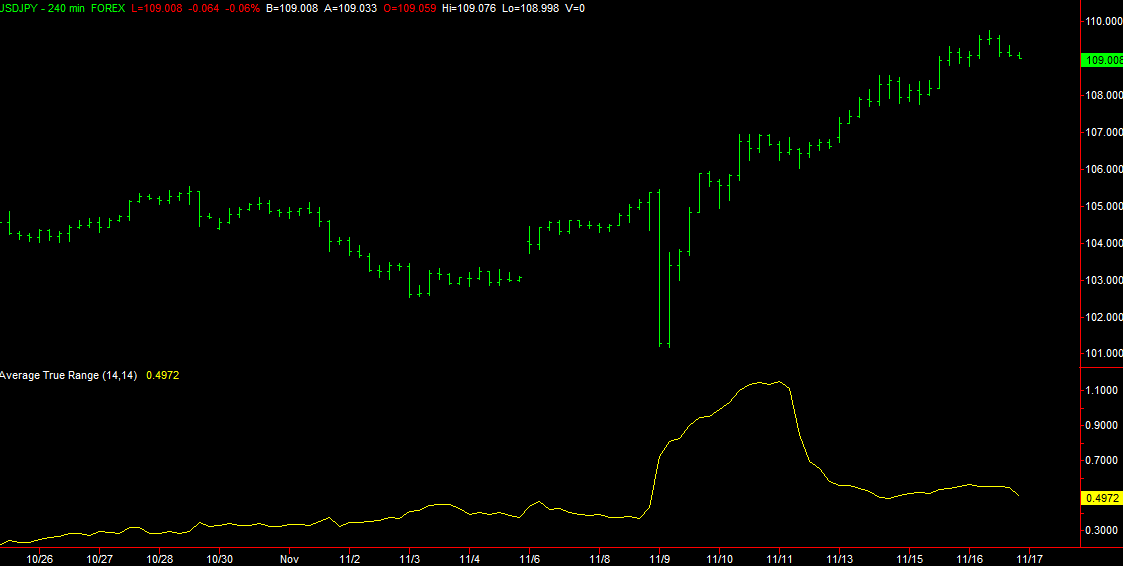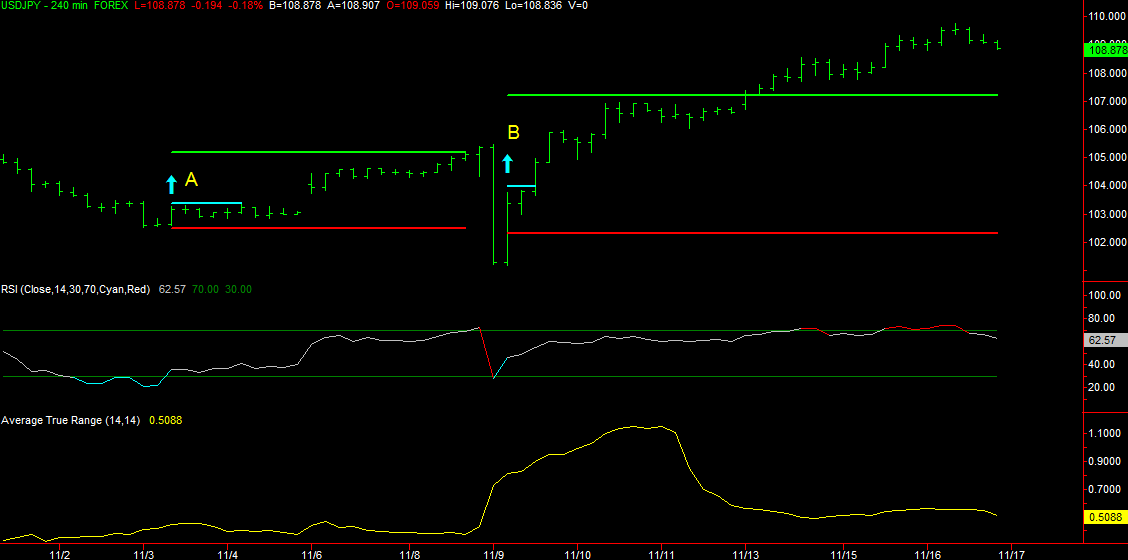We know that markets go through periods of high and low volatility. The size of individual price bars during these periods will also vary, from larger bars during high volatility periods to smaller bars at other times. We can use this to our advantage when calculating the size of our trades and positions by using ATR – Average True Range Indicator.

Figure 1
Take a look at Figure 1. This shows a four hour chart of the USDJPY covering the period around the recent US presidential election. Notice how the average range of the price bars dramatically increased at the time of the election and continues to be higher on average than it was in the month before. Also note that we’ve seen more of a trending move after the election than we did before. This suggests that may be able to book larger trades now than we could in October. To do this we will use the Average True Range (ATR) indicator that’s on the bottom of the chart and is included in all charting platforms.
ATR measures the average of the true range. The true range is very similar to the range of the bar except that it factors gaps into the calculation. That means that if the close of the prior bar is higher or lower than the high or low of the current bar we will use that prior bar close in the true range calculation. We see a good example of that on Nov. 6, 8pm in Figure 1. The high and low of the bar are 104.45 and 103.73 giving us a range of 72 pips. The prior bar had a close of 103.06 however, which is below the low of the 8pm bar and we therefore use that value to calculate the true range which in this case is 104.45 – 103.06 or 139 pips. The ATR then applies a simple moving average to these true range calculations using a default period of 14.
Using ATR to dynamically size our trade setups. What we do is apply different multipliers to the ATR to calculate an entry value above or below the price bar and then determine the initial stop and target placement. As a starting point use the following rules:
- Long setup
– Multiply ATR by 0.25 and add this value to the high of the bar for your entry price. This is the price where you trigger into the long trade.
– Multiply ATR by 2 and subtract this value from the entry price. This is your initial stop price.
– Multiply ATR by 4 and add this value to the entry price. This is your target price.
- Short setup
– Multiply ATR by 0.25 and subtract this value from the low of the bar for your entry price. This is the price where you trigger into the short trade.
– Multiply ATR by 2 and add this value to the entry price. This is your initial stop price.
– Multiply ATR by 4 and subtract this value from the entry price. This is your target price.
As you can see the size of the entry offset and size of the setups will vary with the changing ATR values but the reward:risk ratio will always remain at 2:1. Let’s look at a couple of examples.
We can apply this sizing approach to any of the swing trading strategies that we’ve covered here. Most of those strategies give us a setup bar and suggestions for placement of entries, stops and targets. We can apply the ATR approach instead to any of those setups. As an example let’s use the basic RSI fade system that we covered last month. Figure 2 shows us a couple of setups.

Figure 2
Let’s apply our sizing rules to each of the two setups.
- Long Setup A
– High of the bar is 103.27.
– ATR is 0.44 (44 pips).
– 0.25 times 44 is 11 pips. This is our entry offset so the entry price is 103.27 plus 11 pips or 103.38.
– 2 times 44 is 88 pips. The stop price is therefore 103.38 minus 88 pips or 102.50.
– 4 times 44 is 176 pips. The target price is therefore 103.38 plus 176 pips or 105.14
- Long Setup B
– High of the bar is 103.76.
– ATR is 0.81 (81 pips).
– 0.25 times 81 is 20 pips. This is our entry offset so the entry price is 103.76 plus 20 pips or 103.96.
– 2 times 81 is 162 pips. The stop price is therefore 103.96 minus 162 pips or 102.34.
– 4 times 81 is 324 pips. The target price is therefore 103.96 plus 324 pips or 107.20.
As you can see both trades reached their target. Using fixed stops and targets we risk getting stopped out of trades during periods of increased volatility or failing to reach our targets when volatility is low but the dynamic sizing of our trades allowed us to profit in both cases here. Of course like every system and method that we use in trading we will still see losing trades. On this chart for example there were two short setups after setup B, where the RSI dipped below the 70 level. The last short setup for example triggered in but stopped out. The short setup prior to that however never triggered in because the ATR entry offset calculation placed the entry far enough away. Using a fixed offset on the other hand might have resulted in a trigger and another losing trade.
The values we used in our calculations are a good starting point but can be tweaked through experimentation and back testing. Some suggestions for you to consider:
- Change the period of the ATR calculation. We used the default period of 14 but you can use values between 5 and 25 for shorter or longer term charts.
- Modify the 0.25 entry multiplier if you find that you’re getting triggered into losing trades too often. A larger multiplier will avoid some of those.
- Modify the 2.0 stop multiplier if you find that you’re getting stopped out by choppy price action too often.
- Modify the 4.0 target multiplier or the reward:risk ratio if your trades fail to reach your target too often. A reward:risk ratio of 1.5:1 or 1:1 (multipliers of 3.0 or 2.0) may be more appropriate for your strategy or instrument.
Be aware of the bigger picture in your markets and adjust your trading accordingly. Although this is not the only approach, the ATR provides a simple and straightforward method of adjusting to changing market volatility.
Good luck in your trading.




 Posted in
Posted in